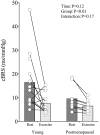Relationship between resting augmentation index and spontaneous cardiac baroreflex sensitivity during handgrip exercise in postmenopausal women
- PMID: 39907405
- PMCID: PMC11793149
- DOI: 10.1590/1414-431X2024e14152
Relationship between resting augmentation index and spontaneous cardiac baroreflex sensitivity during handgrip exercise in postmenopausal women
Abstract
The stiffening of the conductance arteries is a hallmark of ageing and increases drastically after menopause. Therefore, the augmentation index (AIx), a surrogate for arterial stiffness, could be related to the decline in baroreflex sensitivity. We sought to investigate the relationship between resting AIx and spontaneous cardiac baroreflex sensitivity (cBRS) during handgrip exercise in ageing women. Thirteen young women (YW: 24±5 years; 24±2 kg/m2) and nine postmenopausal women (PMW: 60±5 years; 26±3 kg/m2) underwent the protocol, which consisted of 10 min of supine resting followed by 3 min of static handgrip exercise at 40% of the maximal voluntary force. The AIx was provided by the aortic pressure waveform and cBRS was calculated using the sequence technique, and vagal activity was accessed via heart rate variability using the root mean square of successive differences (RMSSD) index. Resting AIx was higher in PMW compared to YW (YW: 8±10%; PMW: 23±8%; P<0.01), while the cBRS (YW: 16±12 ms/mmHg; PMW: 10±5 ms/mmHg; P=0.08) and RMSSD (YW: 46±35 ms; PMW: 34±12 ms; P=0.26) were similar in YW and PMW. At rest, there was no significant (P>0.05) relationship between the AIx and cBRS in YW and PMW. However, in PMW, a negative (slope=-0.22) and strong (r=-0.70; P=0.03) relationship was observed between AIx and cBRS for the increment of blood pressure during the handgrip exercise. The stiffening of the arterial tree is one possible mechanism to explain the decrease of spontaneous cardiac baroreflex sensitivity during exercise in postmenopausal women.
Figures


Similar articles
-
Influence of Age and Estradiol on Sympathetic Nerve Activity Responses to Exercise in Women.Med Sci Sports Exerc. 2022 Mar 1;54(3):408-416. doi: 10.1249/MSS.0000000000002823. Med Sci Sports Exerc. 2022. PMID: 34711708 Free PMC article.
-
Sex Differences in Cardiac Baroreflex Sensitivity after Isometric Handgrip Exercise.Med Sci Sports Exerc. 2018 Apr;50(4):770-777. doi: 10.1249/MSS.0000000000001487. Med Sci Sports Exerc. 2018. PMID: 29135601 Clinical Trial.
-
Effects of alpha-adrenergic receptor blockade on coronary circulation in postmenopausal women.Eur J Appl Physiol. 2023 Dec;123(12):2779-2790. doi: 10.1007/s00421-023-05267-4. Epub 2023 Jun 27. Eur J Appl Physiol. 2023. PMID: 37368136
-
Spontaneous cardiac baroreflex sensitivity is enhanced during post-exercise ischemia in men but not in women.Eur J Appl Physiol. 2019 Jan;119(1):103-111. doi: 10.1007/s00421-018-4004-y. Epub 2018 Oct 6. Eur J Appl Physiol. 2019. PMID: 30293100
-
Effectiveness of exercise training on arterial stiffness and blood pressure among postmenopausal women: a systematic review and meta-analysis.Syst Rev. 2024 Jul 2;13(1):169. doi: 10.1186/s13643-024-02589-y. Syst Rev. 2024. PMID: 38956626 Free PMC article.
References
-
- Karikkineth AC, AlGhatrif M, Oberdier MT, Morrell C, Palchamy E, Strait JB, et al. Sex differences in longitudinal determinants of carotid intima medial thickening with aging in a community-dwelling population: the Baltimore longitudinal study on aging. J Am Heart Assoc. 2020;9:e015396. doi: 10.1161/JAHA.119.015396. - DOI - PMC - PubMed

